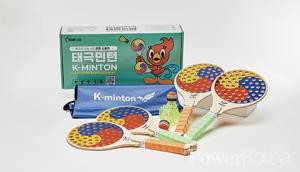 |
||
Jeungdo-myeon, Sinan-gun, Jeollanam-do is the Asia*s first slow city and a salt-producing region registered to UNESCO as a Biosphere Reserve and Ramsar site. Taepyung Salt Farm, the largest single salt field in Korea, covers 4,628,099 square meters and produces 16,000 tons of sea salt annually, making it the center of Korea*s sea salt production. The salt produced here has been recognized for its excellence through strict quality control and has a reputation for being rich in minerals. Designated as a modern cultural heritage site, Taepyung Salt Farm is an interesting place to learn about the history of salt as well as the tidal ecosystem.
Producing the highest quality sea salt by improving production methods and the entire process!
Salt master Heongki Park, a third-generation family member who has been producing high-quality sea salt for 49 years, has been at the forefront of improving the quality of Korean sea salt, and has been making improvements to the facility to make it more environmentally friendly. Park’s ambition is to produce the highest quality sea salt to enhance the brand value of its products and drive public health and discerning consumer trends. Park is demolishing all 4,628,099 square meters of existing facilities and upgrading them with expensive green materials. Park says “We are the only place in Korea where improvements are being made on such a large scale. It was not an easy decision to undertake such a costly project, but I felt that there would be no development in the Korean salt field industry unless someone started.” The improved salt field will produce sea salt only 40 times a year, down from more than 120 times a year previously. Park believes that this will not only improve the quality of the salt, but also increase its production by 20% compared to the previous one, meeting the higher expectations of consumers and contributing to the improvement of people’s health.
 |
First harvest after the rains, Topan salt differentiates itself through traditional methods
Topan salt, the salt of salts produced here, has been described as “distinctly different in flavor” by consumers of high-end sake-making and accounts for 50% of the domestic topan salt market. Park says “The traditional method of doing all the processes by hand is laborious, but I think it is our precious heritage and our destiny that someone has to protect in order to get better quality sea salt.” Park supplies 40,000 bags (1 bag = 20 kg) of salt annually to the domestic market from the first harvest after the rain. This salt produced with freshly harvested water is characterized by low sodium content and a mild taste.
Shinan Sea Salt Industry Special Zone, lacks practical support
Shinan accounts for about 80% of Korea’s total sea salt production, and the government designated Shinan as a ‘sea salt industrial zone.’ However, actual institutional support for farmers is severely lacking. PowerKorea listened to Park’s opinion about what should be done.
 |
The salt industry should be classified as a primary industry!
In South Korea, primary industries such as agriculture and fishing are exempt from the comprehensive income tax, but the salt industry is classified as mining by Statistics Korea despite being a primary industry. As a result, it is heavily taxed and faces huge costs to improve aging salt fields. Of the sea salt consumed in the country, 38% is domestically produced, 20% of which comes from the country’s 880 salt fields, while 62% is imported. The number of domestic salt fields is now down by 50% compared to five years ago, as more and more farmers stop producing sea salt every year due to policy and profitability issues. The abandoned salt fields are being replaced by solar power facilities, and it is feared that Korea will eventually follow Taiwan’s lead. The government should take a proactive role in providing substantial tax incentives and institutional support for sea salt production to grow into a sustainable industry.
Government’s purchase of sea salt should stabilize prices!
Worse still, the price of sea salt has been fluctuating in a vicious cycle. In 2021, when the production cost of sea salt was 16,000 won per 20 kilograms, the selling price at the farmer’s market was sometimes not more than 2,000 won. In such a situation, the farmers are faced with the worst situation of not being able to pay for their labor. Last year, a significant drop in production, coupled with anxiety over the discharge of contaminated water from Japan’s nuclear reactors, caused prices to skyrocket, and now, even in the off-season, they remain high. I have repeatedly called for the government to buy sea salt to stabilize the price, just like agricultural and industrial products, but it is a one-time thing, buying only 1% of the total production. This will only increase the burden on both producers and consumers. Although the price of salt has skyrocketed in the past year, it is actually a normal price. If a consumer buys 60,000 won of salt, it will last a family of four for a year. That’s 40 won per person per day. Salt is the cheapest.
 |
The illegal distribution of cheap imported products disguised as Shinan sea salt must be eradicated!
Another problem is that cheap Chinese salt is often sold under the guise of Shinan sea salt. To prevent this and restore consumer confidence, the government needs to increase oversight and penalties for violations of country of origin labeling obligations and illegal diversion of imported goods.
As the salt farm improvement work costs a huge amount of money, practical support from the government is urgently needed!
Most challenging of all is the huge investment cost of improving salt field facilities. Despite improving the quality of salt pans to meet government requirements, government support is inadequate. In the Shinan region alone, salt farmers have improved 400 hectares, but only 20 hectares are supported by the government. As this is an important industry that produces basic food that is directly related to people’s health, we urge the government to proactively reflect this in the next five-year development program and provide support on a scale that is actually beneficial.
 |
The government must take an active role to develop a sustainable salt power industry!
The salt industry can continue to develop if the government takes the initiative to support it through legislative changes. The government should boldly implement policies that reflect the voices of the field. This is not only for the benefit of sea salt producers, but for the entire population. In addition, I would like the government to activate the sea salt certification organizations, which are becoming less popular, as soon as possible so that producers can receive quality certification with confidence and consumers can purchase certified sea salt with confidence also.
Committed to local economic and social development, Jeongdo Tricolor Flower Festival May 3-10
Recently, Park’s son took over the family business and is the fourth generation to produce sea salt. Training successors is an immediate challenge. As in European countries, the Korean government should establish a training institute for saltmakers to lay the structural foundation for succession. Park served as the chairman of the Shinan Sea Salt Producers Association for about 11 years, contributing to protecting the rights and interests of over 950 sea salt producer members and publicizing the excellence of Shinan sea salt, as well as taking the lead in local economic and social development as the chairman of the Shinan-gun Jeungdo Development Council. A non-profit private organization with 113 members in Jeungdo will hold the Jeongdo Tricolor Flower Festival in the Taepyung Salt Farm area from May 3 to 10. Visitors can see a beautiful feast of salt flowers, rape flowers, and pivi flowers spread across 132,231 square meters of wetlands. Park says “We will continue to strive to improve the quality so that various consumers can safely choose sea salt, which is directly related to the health of the people, and will faithfully serve as a representative for domestic sea salt producers.”
원헤레나 기자 hywon65@gmail.com






